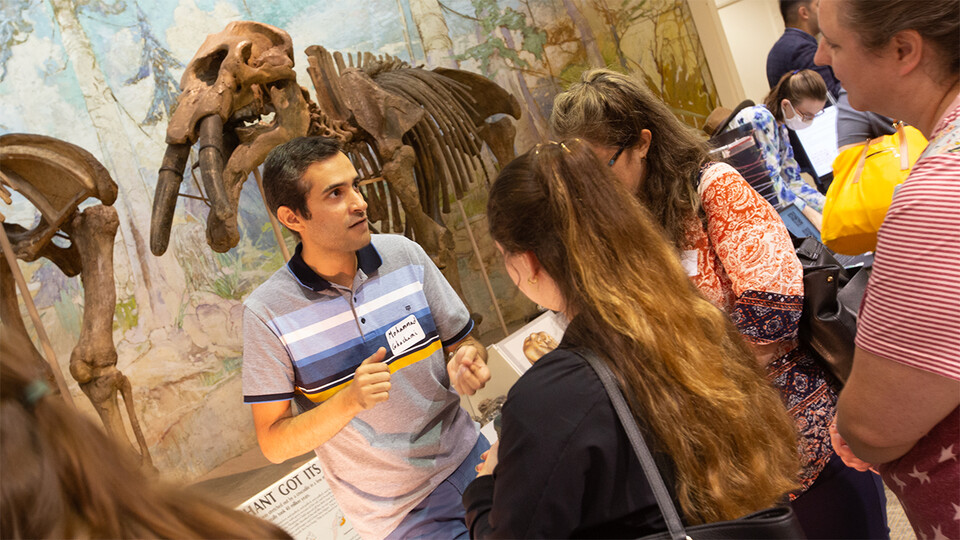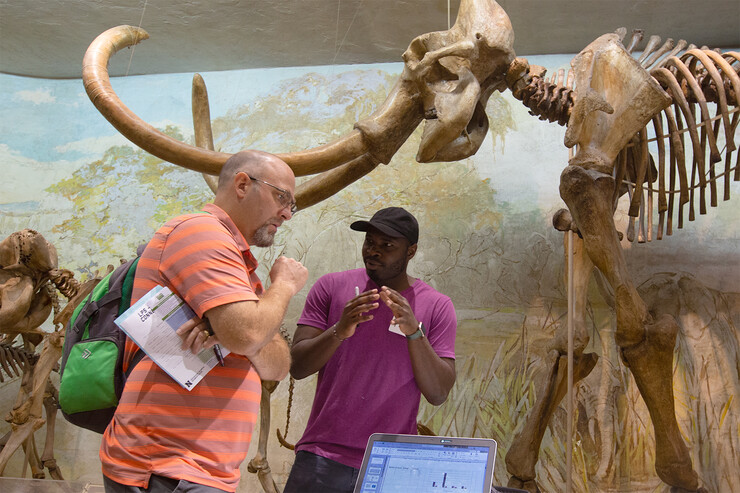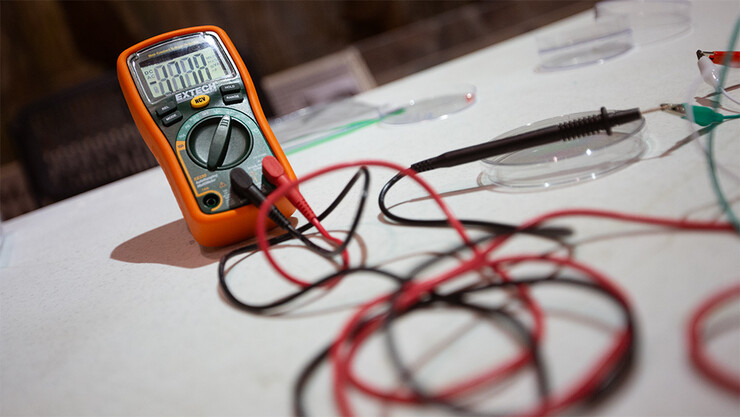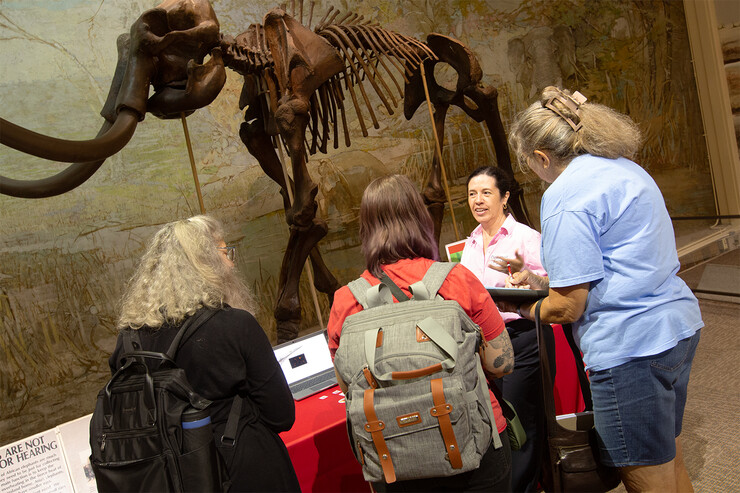· 8 min read
Husker faculty share research with LPS teachers to bolster science ed

The teachers — molders of minds spanning grades 6-12 and the whole of Lincoln Public Schools — surveyed the tables arrayed throughout the hall, then the science projects arrayed on them.
Displays on nanoscale physics and the trajectories of celestial bodies. Explanations of how magma forms and plants fall ill. Demos, overviews and outlines of mixed reality, augmented reality, artificial intelligence, smart materials and advanced robotics.
Behind the tables stood figures more than ready to talk, willing to listen and able to answer whatever questions might come their way. So the teachers engaged, inquired, took notes. This was, the teachers agreed, an exceptionally bright group of scholars.
With good reason. This was not, after all, just any science fair. This was a science fair — better yet, a STEM fair — featuring 22 faculty and research groups from the University of Nebraska–Lincoln.
Those Husker researchers gathered Aug. 9 in Morrill Hall to share their latest work with 150-plus LPS science teachers who, in turn, will leverage the lessons to better educate and prepare the students streaming back to their classrooms in less than a week’s time.
“They’re going to impact so many students by empowering the teachers to bring some of this cutting-edge research into the curriculum,” said Nebraska’s Jocelyn Bosley, who recruited faculty to participate in the event. “I think teachers are very hungry for that kind of novelty and innovation. They really want to innovate and work with their students in newer, better ways. And what better place to learn how to do that than from the experts who are out there creating all this new science?”
Since its emergence in the mid-2010s, the event’s coordinators — beginning with Nebraska’s Judy Diamond and LPS’s James Blake — have strived to maximize its usefulness for middle and high school teachers. For the 2023 edition, that meant having teachers identify concepts in the Husker research — cause and effect, for instance, or energy and matter — that bridge multiple STEM fields and are part of the Next Generation Science Standards adopted by many states, including Nebraska.
Bosley, who once served as a mentor at Lincoln’s Irving Middle School, said honing that holistic perspective can also help teachers and students better grasp the processes, practices and philosophies that constitute science.
“You may not understand a particular science concept, but if you understand how science works, then you can appreciate the concept,” said Bosley, a research impact coordinator with the Office of Research and Economic Development. “You can appreciate how science is different from other kinds of knowledge bases or belief systems. And you can understand how that piece of knowledge was vetted, and what questions still remain, and the fact that new evidence coming in doesn’t (necessarily) mean that it was wrong before. I think all that knowledge of scientific process is really key, and the cross-cutting concepts are a great way to equip teachers to address some of those issues, too.”
This year, those teachers included Katie Hale-Olbricht and Aiden Skillstad, who teach physical science and geoscience to freshmen at Lincoln North Star High School. Hale-Olbricht, a three-time veteran of the event, recalled visiting the fMRI system at the university’s Center for Brain, Biology and Behavior alongside her husband, who eventually incorporated what he learned into a lesson plan on nuclear medicine.
As a first-time participant and Nebraska alumnus, Skillstad encountered one of his former professors — Lynne Elkins, associate professor of Earth and atmospheric sciences — heading up a booth on the origin of magma and formation of islands. After catching up, Skillstad learned that Elkins’ research relies on absolute dating: measuring concentrations of certain atoms in rock or sediment to determine how many of those isotopes have decayed and, by extension, how long the rock or sediment has existed.
“That’s really exciting for me,” he said, “especially as a geoscience teacher, because we talk a lot about relative and absolute dating in geologic time.
“I just think it’s really cool for them to show what new technology they’re incorporating, what new science they’re doing. It’s their platform to tell us what’s important to them right now at the postsecondary level, and how we can help get our students to where (the faculty) want them to be for taking the next steps in their careers. So it’s good for us to have a collaboration.”
The two North Star teachers also endorsed the focus on cross-disciplinary concepts, which LPS and other Nebraska schools are endeavoring to integrate from kindergarten onward.
“To see that the collegiate level is also bringing those concepts in to help us engage a little bit more, I think that’ll help get some (LPS) students to go into science in college, as well,” Hale-Olbricht said.
Oghenetega Allen Obewhere, a doctoral student in chemical engineering who researches in the lab of Nebraska’s Shudipto Dishari, was doing his part to provide teachers with a “simple experiment that they can perform from the comfort of their classroom.” Alongside a couple of other grad students, Obewhere occupied a table lined with materials available at the local grocery or hardware store: filter paper, some table salt, copper and zinc, a multimeter to measure voltage.
But introducing two of the research group’s signatures — oppositely charged polymers derived from the cell walls of plants — effectively transformed a conventional battery into a renewable power source. In that way, Obewhere said, it’s a fundamental glimpse into the group’s engineering of greener fuel cells. The DIY device also demonstrates the conversion of chemical energy, via salt, into electrical energy.
“Professor Dishari is someone who really is passionate about reaching out to the younger generation to increase their passion for STEM,” Obewhere said. “So when this opportunity came, we jumped right into it.
“I really like this LPS event, because in the past, we’ve had researchers conversing with the students. But I think conversing with the teachers, and trying to understand what they are trying to do, the efforts they’re making — and then having them tell us how we could also be of assistance — is also good. We need more of these kinds of events.”
It doesn’t hurt, Obewhere said, that the event offers another way to share what he and his colleagues are dedicating their careers to — not to mention the thrill of discovery fueling that dedication. That makes it a valuable respite from the rigors of academia, he said, especially the months- or years-long efforts necessary to see research results published in an academic journal.
“Coming here to interact with the teachers makes us happy, makes us know that our research is valued,” he said. “It gives us that sense that we are contributing.”
Though the participating faculty hail from across the academic spectrum — some have earned tenure, many have not — Bosley said she tries not to round up “the usual suspects,” the researchers with years of experience and comfort communicating their science. Instead, she often seeks out those who might benefit from polishing their deliveries, or putting themselves in the headspace of those whose brains are not stuffed with the same expertise.
The LPS teachers who might find themselves a bit intimidated asking questions of a university professor, Bosley said, might also be surprised to learn that early-career faculty often feel some anxiety ahead of the event, too.
“I think it just speaks to the fact that both groups have so much to learn from each other,” she said. “And I think it’s fantastic to have practice expressing your work, explaining your work, just discussing your work with multiple audiences who are coming at it from different perspectives. It can help you see your research in a different way, and maybe even stimulate a line of thinking or a research question that you hadn’t really thought about asking before.”
Julia McQuillan, a Willa Cather Professor of sociology who has earned multiple grants to help support the event, said it presents another opportunity that any sociologist could appreciate: the chance to connect with peers. It’s not unusual, she said, to see teachers making up for long-time, no-see, reminiscing over shared time at a previous school, giving and getting the sort of social support that’s essential for those in such a pressurized career.
Hopefully, she said, that esprit de corps is also spurring progress toward one of the event’s broadest, longest-term but most important aims.
“From a sociological perspective, I want every person to see that science is for them,” McQuillan said. “Science is an important capital to manage our lives, to navigate our lives. So we want everybody to feel that science is for them, and that anybody who wants to can become a scientist.
“This helps us work with people to figure out how to do that.”










